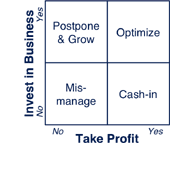We use the term “2 x 2 Thinking” to describe a powerful approach to problem-solving that we have observed, documented and taught in our work as consultants and business advisors. It’s a method that recognizes that dilemmas are inherent in business and uses creative tension as fuel to drive innovative solutions and break the logjams that impede strategic decision-making.

In the book, Power of the 2 x 2 Matrix, we present fifty-five remarkable 2 x 2 frameworks. These were carefully chosen, (from more than 300) to help managers and institutions organize and focus problem-solving efforts. We find that nearly all 2 x 2 models share a common structure, one which is responsible for their strength. 2 x 2 models can range from the highly intuitive to the ingeniously complex. Classics such as the BCG Product Portfolio (familiar to any business school grad) or Stephen Covey’s Urgency vs. Importance (well-known to the millions of people who have read his books) help frame the common tradeoffs that organizations and individuals face. Others such as the perceptual maps frequently used in competitive marketing analysis, are more taxonomic, defining possible areas of focus and action, and creating a sound basis for decision-making.
It is the underlying dynamic structure of 2 x 2 modeling that brings richness, depth and a uniquely transformational power to this simple form. There is a right and wrong way to construct a 2 x 2 matrix, and the key lies in how the prime factors are selected and applied. Successful application is dependent on a particular cognitive and emotional bias in approach, which we call 2 x 2 Thinking. 2 x 2 Thinking is open as opposed to closed, proactive, and drawn towards inherent conflicts in search of resolution. The very best instances of problem-solving share a number of characteristics which comprise the core of 2 x 2 Thinking. The following seven points illustrate this more fully:
* 2 x 2 Thinking leads to an open exploration of issues to unearth inherent tensions; these tensions exist within an evolving context, where focus shifts as old points are resolved and new tensions emerge.
* 2 x 2 thinkers recognize the importance of learning as both a condition for change and a key enabler; learning involves embracing the new and letting go of unhelpful and invalid views.
* 2 x 2 Thinking is often but not necessarily interpersonal; where others are involved, dialogue is rich, informative and honest.
* 2 x 2 thinkers move towards not away from complexity; the act of focusing on a core set of variables does not reduce or simplify analysis – it enriches it.
* 2 x 2 Thinking requires openness leading to rapid modeling and reframing; problems are re-considered, and underlying assumptions are vigorously challenged.
* 2 x 2 thinkers are drawn to seeing both sides of an issue; this often leads to paradoxical situations which are explored rather than denied or ignored.
* 2 x 2 thinkers simplify to intensify focus; confusion is replaced by a core dilemma that holds the key to deeper meaning and more informed choices.
The simplest 2 x 2 problem-solving behavior involves looking at the other side of an issue before reaching a conclusion. A simple “what if” exercise will accomplish this. Dilemmas are a more interesting case. Dilemmas pull us simultaneously in competing directions, each one compelling in its own right. While dilemmas rarely feel good, they often contain the seeds of deeper understanding and a superior solution than we are otherwise capable of finding. The trouble with our experience of dilemmas is that they generally happen to us, and we feel out of control. 2 x 2 Thinking recognizes the power in exploring competing forces. By intentionally constructing dilemmas, we challenge ourselves to think at a higher logical level

Often it is not really about choosing one or another option. Something is missing in the decision process. It could be perspective, excitement, confidence, agreement among parties, or additional alternatives. Here’s an example: Should we invest in growing our business or should we take profit now? This simple dilemma has caused thousands of business owners sleepless nights over the years. Viewed as a simple and straightforward choice, it is not very interesting or enlightening. However, a poorly thought through decision based in fear, greed or misplaced confidence can prove hazardous to the business over time. In contrast to this, we can construct a 2 x 2 decision-matrix to intensify and deepen the way we think through the issue. Looked at in this way, there are really two sets of choices to make rather than one. And, it may not have to be a forced choice between this and that. In the best of cases, it is possible to realize both ideals by reframing the question, seeking a solution that is both/and rather than either/or. This is what we call a transcendent solution.
Transcendent both/and solutions are all around us in the business world. Southwest Airlines is both a discount carrier and highly profitable, a combination that conventional wisdom said was impossible when Southwest was crafting their strategy two decades ago. When IBM had been battered by years of losses, Lou Gerstner turned a deaf ear to Wall Street’s demand that he sell off parts of the company in order to get back to basics. Instead, by focusing on services as the main offering to customers, he was able to leverage and recombine the company’s expertise in semiconductors, computers and software and return to record profitability. Toyota was long a low-cost leader in automobiles, but also became a quality leader when it introduced its Lexus brand, bringing the values of maintenance-free reliability into the luxury car market. Today, it is a leader in low-cost production and high-quality luxury cars, positions that were previously considered an either/or option for manufacturers. In all these cases, and many more, strategists were willing to challenge previous assumptions, and reframe competitive dilemmas in a way that enabled them to create innovative positioning and solutions that others could not match.
All materials copyright Transcend Strategy Group 2009
